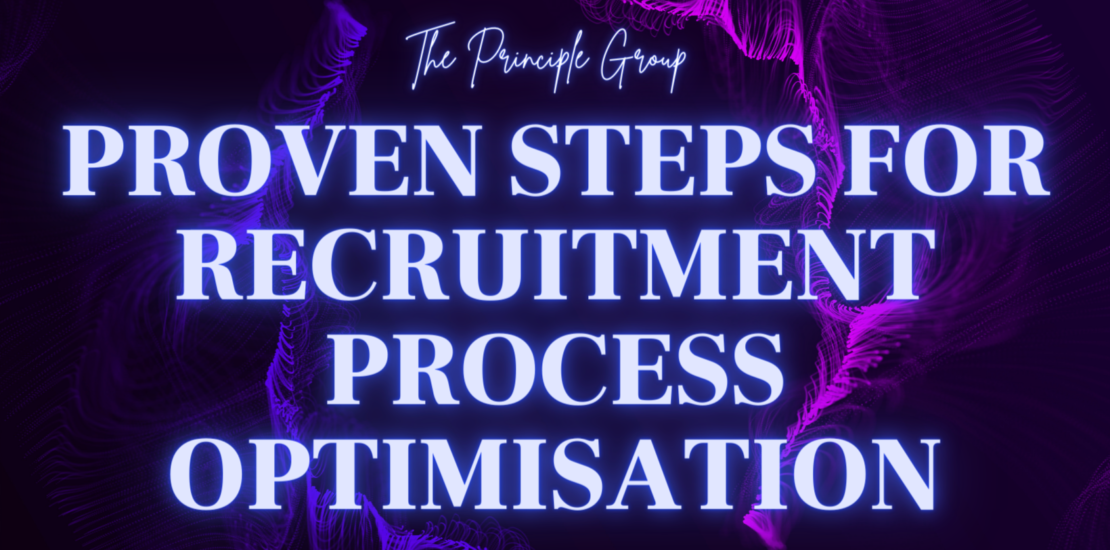- December 14, 2022
- Posted by: principlegroup
- Category: Uncategorized

Recruitment process optimisation can directly impact your people management and, thereby, your business. You can use a logical process to achieve a superior-tech stack. With updated technology across the process, some of the leading firms are sourcing the best talent for their business.
There are many ways you can bridge the technology divide if you feel that you are not getting the best people for your work. People are the most critical resource for business success.
Therefore, it will be worthwhile for your firm to overhaul the recruiting tech stack to optimize the recruitment process. But how do you optimize the hiring process?
Technology comes into play in many ways in your hiring process. To optimize your outcomes, you can break the cycle into segments and optimize each sub-segment. While ad hoc improvements also make a difference, the following steps can give you a strategy to optimize the hiring process.
How to Do Recruitment Process Optimization
The following steps can make recruitment process optimization logical and orderly:
1. Identify the goals
You should state the core goal you want to achieve through the process. It can be anything — finding the most competent candidates, better background check, faster hiring, getting more applicants, filtering the applications quicker, etc.
You can take an even more strategic view and consider the business goals you want to achieve. This approach will help you identify the kind of people required to achieve those goals. Once you gap in your human resources needs, you can undertake an effective recruitment process optimization.
2. Work on the technology backbone
Each of the tasks in recruitment has to be well-constructed in the technology process — candidate applications, data management, accessibility of the data, the quality of each of these steps.
With a strong technology backbone, there is a good foundation upon which you can build. However, if there is a lack of some basic tools, you can take the appropriate steps to add to your tech armory.
3. Document and report
Organizations often underestimate this step. Many ideas will emerge based on what you have identified as your goals and having evaluated the technology backbone. You need to document these aspects.
The report you create will serve as a valuable tool to make your team, vendors, and agencies do their jobs well. Communication gaps that arise will be lower.
4. Assess all the available technology tools
For each of the segments of the recruitment process, there are separate technology tools. For example, recruitment marketing, candidate applications, filtering, selection, and onboarding are all parts of the hiring process that entails using tech tools for HRs.
Make a thorough assessment of the tools you are currently using. There are 100+ tools available to you — Jibe, Smashfly, Beamery, Phenom People, Hundred5, Pymetrics, BambooHR, Emboarder, Talmundo, etc. Make a comprehensive list at this stage so that no idea is left out.
5. Strategic considerations
While we may have the highest ambitions concerning technology usage, feasibility is an important consideration. Having analyzed the tools for your goals, you should evaluate your objectives, availability of technology experts, and budgets.
Time may also be a critical consideration as companies want to move fast and furious to capture markets. So they want their recruitment processes organized within a time frame.
6. Benchmarking
Once you identify your goals for your recruitment process optimization and have your strategic considerations in hand, you can now set a benchmark for yourself. You can also optimize the hiring process with reasonable means.
You may be able to study a tech stack of a company that you think should be emulated.
7. Implementation
Implementation is a trial and error process. As you implement the technology you have zeroed down upon, you will encounter bottlenecks and gaps. However, keep addressing them and move forward to come closer to your recruitment goals.
There are numerous tools available to troubleshoot the problems you can encounter and build a robust tech stack.
8. Assessment
Once you have implemented your ideas and tried to reach your goals, it is time to make a documented assessment of all the improvements, shortcomings, and glitches. Documentation will help you create a system to close all the gaps in the performance and end the optimization cycle.
9. Future Planning
Future planning is not just for some uncertain, long-term future. Technology disruptions are widespread. It is necessary that whatever is implemented reflects future planning. Database management and AI are some areas in which evolution is taking place fast. Make sure that your tech stack strategy is flexible.
Wrapping Up
The increased usage of AI in recruitment represents the giant leap in the hiring process in just ten years. A decade ago, going to a job seeker website was the only technology used!
The recruitment tech stack has evolved to do a great job in a pandemic where employees are needed remotely. Companies are encountering various recruitment considerations. Quite often, they need to hire with limited or even zero physical interaction with a candidate. An optimized recruitment tech stack is required to undertake onboarding and background checking that is necessary today.
With companies looking at technology to get the best people for their work, recruitment process optimization is a must. The pandemic has disrupted technology itself; even tech-savvy firms are going to external agencies to get their tech stack in order.
